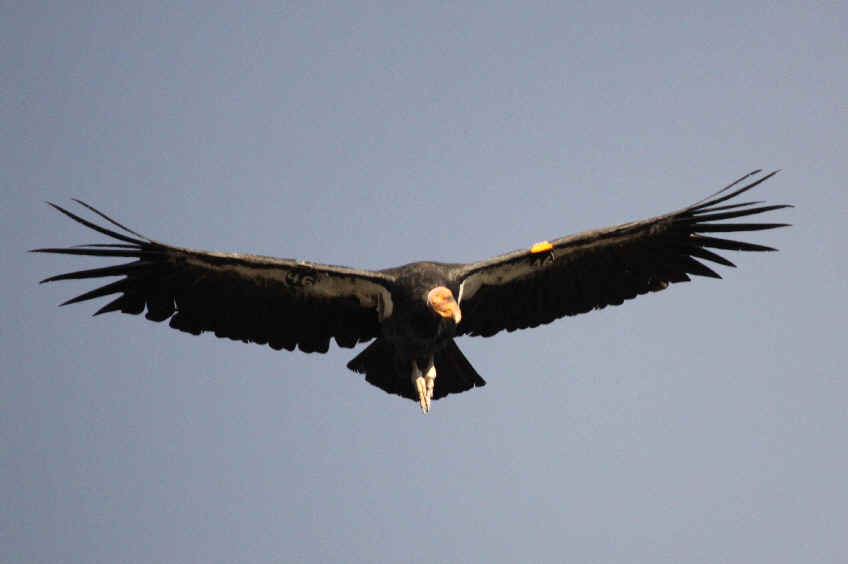The BIRDLINE by ARMAS HILL
From
Midway to a Mountain in Maine, and Much in Between
Armas Hill has presented the "Birdline", originally from
Philadelphia, on the phone and internet for over 3 decades, and on the radio
in Delaware for about 10 years.
Links:
A
List & Photo Gallery of North American Birds, in 6 Parts
A
List & Photo Gallery of North American Mammals


A California Condor at the
Grand Canyon in Arizona,
photographed during a FONT tour
The Birdline for December 9, 2011:
On December 1, the world's oldest known LAYSAN ALBATROSS,
a female, was seen for the first time this breeding season, at the
Midway Atoll National Wildlife Refuge, on Midway Island
in the Pacific Ocean.
Earlier this year, she survived the tsunami caused by the
Japanese earthquake in March. Now she has returned to Midway, with
her mate.
This ALBATROSS has been named "Wisdom".
When found this past week, she was incubating an egg. She is at
least 61 years old.
Back in 1956, she was banded, as a nesting adult, at the same
location by Chan Robbins. At that time, the bird was estimated as
being a minimum of 5 years of age.
The current oldest known albatross of any kind, now in the
world, appears to be a NORTHERN ROYAL ALBATROSS that
nests on the South Island of New Zealand. Also a
female, she is also named. Her name: "Grandma", and
her age is said to be more than 61 years.
Belatedly, here, the news that the first MOUNTAIN BLUEBIRD ever in
Maine was photographed on November 13, on a
mountain. It was at the summit of East Royce Mountain in South
Oxford.
A TUFTED DUCK has been in Weld County, Colorado,
first found at the Firestone Ponds.
Only twice previously, has that species been found in that state.
The TUFTED DUCK is common across northern Eurasia, from England to
Japan.
5 WHOOPING CRANES were seen on December 3 in Illinois,
along the river with the same name, south of Hennepin in
Marshall County.
Now, a note regarding another very rare bird in North America, the
CALIFORNIA CONDOR: The U.S. Fish & Wildlife Service says that
about half of the roughly 130 CALIFORNIA CONDORS released since
1996 along the Arizona/Utah border have either
been known to have died or vanished.
The number 1 cause of the deaths, it is said, is poisoning from
lead fragments left by bullets in animal carcasses.
Still, the species is gaining a foothold. About 70 CALIFORNIA
CONDORS now range Arizona's Grand Canyon
to southern Utah's Zion National Park.
In the state of California, which bans lead
bullets in "condor country", there are an additional 111
CALIFORNIA CONDORS in the wild.
The total population of the species in the wild is now nearly 400
individuals, including some in Mexico.
This information is from the December 2011 "Beakly
News", and the Associated Press.
For some reason, a PRAIRIE FALCON has been wintering in
south-central Pennsylvania in Cumberland County,
north of Shippensburg. It has
now returned there for the 6th consecutive season, in the
area of Mud Level Road, and often, but not always, by the
intersection with Duncan Road.
On the level, it's not really understood why that bird has been
there year after year. As I said, it has "for some
reason". Maybe someone has some thoughts? An interesting
thought is to wonder where that bird is other than in winter.
A juvenile BROWN BOOBY that's been in Massachusetts,
at Provincetown Harbor on Cape Cod, has continued there, at least
periodically.
Some other notable birds that have continued in Massachusetts
include:
the 4th-ever CASSIN'S KINGBIRD in the state in West Newbury,
a BARNACLE GOOSE, also in West Newbury (at least, as of a few days
ago)
an ASH-THROATED FLYCATCHER in Eastham (another has more recently
been found in Rockport),
2 SANDHILL CRANES in Rowley, and
2 SNOWY OWLS at Duxbury Beach.
A female PAINTED BUNTING has been on Nantucket Island,
Massachusetts.
Close to Massachusetts, in the little (the smallest) state of Rhode
Island, there has been an ASH-THROATED FLYCATCHER in
Middletown, as of December 4.
2 SNOWY OWLS were seen in Rhode Island on December 6.
In all, 330 species of birds have been seen in little Rhode Island
this year, as of the end of November.
Going back to Pennsylvania again (and we will
again yet), along the shore of Lake Erie, at the Presque Isle
State Park in Erie, on December 6, a total of 8,879
RED-BREASTED MERGANSERS were counted, as they were seen
flying by. Two-thirds of them were flying low, and east. One third
were flying high, and west.
A single PURPLE SANDPIPER also flew in and out.
Not far from the east end of Lake Erie, a SLATY-BACKED GULL
has been at Niagara Falls, along the New York-Ontario
border. It has been above the Horseshoe Falls, in both
the US & Canada.
Also in that area, there have been LESSER BLACK-BACKED GULLS, and
ICELAND and GLAUCOUS GULLS.
Still, in the Niagara Falls area, there have also been:
a FRANKLIN'S GULL, BLACK-LEGGED KITTIWAKE, and LITTLE GULLS at
several locations along the lower river.
Rare in that area, there was a juvenile POMARINE JAEGER on
December 3 at the lower river power plant, and juvenile PARASITIC
JAEGERS have been about, below the falls, for several days.
In upstate New York, a YELLOW-THROATED WARBLER has
been in Onondaga County where the Onondaga Creek meets Onondaga
Lake.
In New York City, in midtown Manhattan (yes, in
the middle of the city), a YELLOW-BREASTED CHAT was seen on
December 6, at about noon, from the main Public Library patio,
looking down at the shrubs. The bird, foraging silently below,
would not have been visible from the street (either street: 42nd
Street or 5th Avenue).
Elsewhere in New York City, a BARROW'S GOLDENEYE was at the
Jamaica Bay National Wildlife Refuge on December 3.
In New Hampshire, a male BARROW'S GOLDENEYE was along
the seacoast in Hampton on December 4th.
Also along the New Hampshire coast, in Rye, on December 5, a
DOVEKIE, that was briefly stranded on land was eaten by a
RED-TAILED HAWK.
During a boat-trip, offshore from Hampton, at Jeffrey's Ledge, on
November 27, over 250 DOVEKIES were seen, safe out there.
Inland in New Hampshire, lately, there were 4 EVENING
GROSBEAKS in Jefferson, and 87 PINE SISKINS were counted
(apparently precisely) in Lebanon on December 5.
In Maine, 11 SANDHILL CRANES were in Norridgewock
on November 30. That same day, 2 SANDHILL CRANES were by the post
office in West Poland, Maine.
9 SANDHILL CRANES flew over the hawkwatch at Blueberry Hill (where
someone "found their thrill") in Granville, in western Massachusetts,
one day this past week. (It was such a thrill, they forgot to
report the date.)
In Pennsylvania, at least 2 SANDHILL CRANES were
seen in Lebanon County on December 5, near the Harper's Tavern
Bridge.
In northern New Jersey, 4 SANDHILL CRANES were
observed in Somerset County, on December 3, at Zarepath, by the
Delaware & Raritan Canal.
Also in Somerset County, GEESE lately have included: ROSS',
GREATER WHITE-FRONTED, CACKLING, CANADA, and BRANT.
A BARNACLE GOOSE was found on December 3 at Califon, in
Hunterdon County, near the Raritan River.
A GREATER WHITE-FRONTED GOOSE has been near the town of Raritan,
in Hunterdon County, at the Duke Island Park.
Also in northern New Jersey, a SNOWY OWL has continued at the
Merrill Creek Reservoir, in Warren County, as of at least December
5.
In Berks County, Pennsylvania, a GREEN-TAILED
TOWHEE has continued at the Blue Marsh, northwest of Reading, and
a HARRIS' SPARROW has continued near Kempton, seen today, December
9.
NORTHERN SHRIKES have been at various place in Pennsylvania. Some
have included these:
in Centre County, today, December 9, between the new Nature
Inn and the lower park road,
in Cambria County, at Lake Glendale in the Prince Gallitzin State
Park, at least as of December 2,
in Luzerne County, at the Moon Lake Park, on December 6,
in Wayne County, today, December 9 (on private property),
and at the John Heinz National Wildlife Refuge, near the
Philadelphia Airport (there thru December 5).
2 NORTHERN SHRIKES were in northern New
Jersey in Sussex County on December 13.
In Maryland, a NORTHERN SHRIKE was at the
Piscatoway Park on December 3, where also there have been as many
as 4 RED-HEADED WOODPECKERS.
A LOGGERHEAD SHRIKE has been in Maryland, near Hagerstown, as of
December 5.
Along the Maryland seacoast, birds at Assateague lately have been
a LARK SPARROW, as of December 9, and a "AUDUBON'S"
YELLOW-RUMPED WARBLER on December 3 & 4.
An EARED GREBE was at Point Lookout, Maryland, on December 3.
BLACK-HEADED GULLS have been, this week, in Maryland, Pennsylvania,
and New Jersey.
In Maryland, at the Hunt Valley Mall, on
December 9.
In Pennsylvania, at the Moraine State Park, in
Butler County, as of December 9.
In New Jersey, at the Shark River Inlet, along
the North Jersey Shore, on December 8.
Nearby, at the Manasquan Inlet, that same day, there was a
LITTLE GULL, where also there were BONAPARTE'S GULLS.
Along the southern New Jersey Shore, a late
OSPREY has been north of Cape May, along the Garden State
Parkway, by mile marker 3. It was still there, in that area,
as of today, December 9. The hawk was hovering by the
highway.
To see about OSPREYS that now much further to the south, click
here: http://www.bioweb.uncc.edu/bierregaard/migration11.htm
A WESTERN TANAGER was seen in Williamsburg, Virginia
on December 2 & 4.
A DICKCISSEL has been in Washington DC at Hain's Point.
Flocks of SNOW BUNTINGS, lately, have been:
90 birds in Bayonne, New Jersey, at the Ocean
Terminal (across the Hudson River from New York City), and
60 birds at Cape Henlopen, Delaware (across the
Delaware Bay from Cape May, New Jersey).
Single RED-THROATED LOONS have been this past week in Pennsylvania:
at the Green Lane
Reservoir in Montgomery County on December 3,
at the Bimini Lake in Clearfield County on December 7, and
at the Beltsville Lake in Carbon County, also on December 7.
But the last report is especially interesting as it was said
that the RED-THROATED LOON was heard calling back and forth with a
COMMON LOON.
And that is our last report here.
Armas Hill has presented the Birdline, originally from
Philadelphia, on the phone and internet for decades (3), and on
the radio in Delaware for years (10).
The Birdline (and the Natureline)
are affiliates of Focus On Nature Tours.
To see about FONT tours, past & future, please go to the website:
www.focusonnature.com
To read about the most-recent FONT tour in Chile:
http://www.focusonnature.com/ChileNov2011TourNarrative.htm
For past Birdlines & Naturelines: http://www.focusonnature.com/Birdline.htm
To
Top of Page


